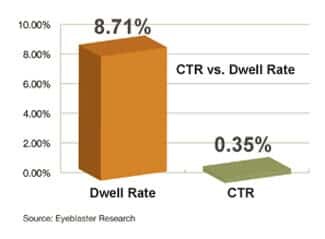Advertising executives appear to be determined to prove that their industry really is worth it. Take a look at the latest whizzer idea from Eyeblaster – “dwell rates“. Apparently, we “dwell” on online advertising considerably more than we click through. According to the research, on average, we are 25 times more likely to engage with an advert than click on it.

The research also shows that video advertising is the most engaging, with viewers spending as much as 200% more time on a video advert compared with a static one.
Well, hold the front page Mr Editor, this is shock horror news…..not!
Firstly, this research shows us that 92% of people do not even dwell on advertising, let alone click through. Yet again, it is confirmation that online advertising simply does not connect with most people using the Internet.
Secondly, it also shows how dreadful the adverts must be. If people engage with the advertising but fail to do anything as a result, what is the point of the advert. “Ah, we knew you’d ask that,” says the advertising industry, “branding”. Engaging with the advert, but not doing anything merely helps us remember a brand – for which, of course, there is no actual evidence.
But consider this latest Eyeblaster study; it tells us nothing we didn’t already know. For instance, if we measured newspaper advertising engagement based on the amount of time the page was open we’d almost certainly find that more people looked at the adverts than who actually did any of the calls to action in them. Equally, TV advertising “dwells” will be quite high as the TV is switched on, in the corner of the room, while we wait for the break in our favourite programme to end. The TV advertising industry has never been able to truly measure the impact of its advertising – relying largely on hope and guesswork for its millions being spent.
Indeed, the Eyeblaster report makes it clear that unlike TV advertising, online “dwell rate” studies can provide you with accurate metrics to show the benefit of your advertising. The industry will grab hold of this concept and use it to confirm things like “we switched your advert to video and got 187% more engagement from people, Mr Advertiser”. To which, the hapless advertiser will say “Gee, that’s great” and will look at the fancy graphics with glee.
But, in the final analysis, there is only ever one statistic that counts with advertising: does your product or service make more money as a direct result of the adverts? You don’t need fancy metrics, you don’t need to start worrying about a whole host of web analytics and metrics. You only need your sales graph.
More importantly for advertisers – as far as trying to engage your audience – is the website you place your adverts on. New research from Hong Kong shows that whether we engage with advertising is linked to the design and complexity of the surrounding page. If the editorial material is difficult or poorly designed we also view the advert as difficult to read (even if it isn’t) and thereby don’t engage with it. This suggests that rather than worrying about the advertising itself, advertisers should focus their attention on the layout, design, usability and readability of the websites they want to advertise on. If those sites are poorly constructed, your adverts will have low impact, no matter how good the “dwell times”.
As many advertisers have known by instinct, you only really get results from adverts by having quality adverts that truly engage people, in quality publications that are professionally put together. Sadly, both of those are few and far between online, which is probably why so little online advertising actually produces results – in spite of these seemingly significant “dwell rates”.
